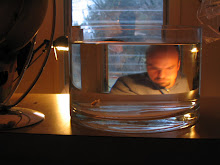For better or for worse, one of the most deeply established elements of Cleo's daily routine is her morning video. It's not always the first thing we do - sometimes the day kicks off with a book, or a dressing session - but usually by 7 a.m. she's settled in her big black Thinking Chair, with a cup of warm milk in her hands, and an age-appropriate video all cued up.
But of course as Cleo grows older, the material that suits her changes. The mild chaos of Max and the cool-headed practicality of Ruby once appealed, but then gave way to the slightly more complicated narrative arcs of Curious George cartoons. For a time, this summer, the raw energy and seasonally-apt inventiveness of Phineas and Ferb (two boys who are determined to make the most of their summer vacation) was what she wanted. And now, intriguingly, it's Buster Keaton.
You've probably heard of Keaton, even if you don't remember the name. An exact contemporary of Charlie Chaplin, he was the more physical and acrobatic counterpart to Chaplin's elegant grace: in the relatively small world of silent film comedy, Keaton was Gene Kelly to Chaplin's Fred Astaire. You turn to Chaplin's films for the expressive possibilities of a flower held in clenched teeth, or for hints of substantial social criticism; if you're in the mood for wild chases and antics on the roof of a moving train, though, Keaton's your man.
And now he's Cleo's man, too. When I first showed her a Keaton sketch - a year ago, after picking up a DVD at a thrift store while on a road trip with her - she was downright frightened by a scene in which a bumbling family man, played by Keaton, somehow manages to drive his model T into a harbor. It's meant to be a silly scene, with Keaton as an unharmed buffoon, but Cleo had never seen anything like it, and she asked me to turn it off. Every now and then, in the subsequent months, she would occasionally refer in a slightly awed manner to the car in the water, and would sometimes even insinuate - echoing my apologies - that I should not have shown it to her.
But, recently, she announced that she wanted to see it again. I emphasized that it's just a movie, and put it on and read the title cards to her, as they appeared, in a slightly simplified manner. And, as you can see in the video above, she's grown into something of a fan: she understands the weird eccentricities of Keaton's wildly engineered electric house, and the charm of his inept attempts at boatbuilding. So the plots appeal. But might other elements, too? Keaton's films, of course, feature no dialogue, but they do embody a strong sense of rhythm - rhythm that's sometimes manifested in the accompanying music, and that is also implicit in Keaton's comically rapid motions and the relatively quick cuts from scene to scene. In watching the films with her, I've come to see them as antecedents of later Warner Bros. cartoons: they evoke both the quickness of the Road Runner and the narrative velocity of, say, a short involving Sylvester the Cat. They're jazzy, in short, rather than symphonic, and percussive, rather than lush. And while Cleo may, in time, grow interested in videos that can evoke the complexity of a Brahms composition, we're more than satisfied for now with films that speak a musical language - concise, energetic, rhythmic - that seems to be that of many 3-year-olds.

.JPG)




